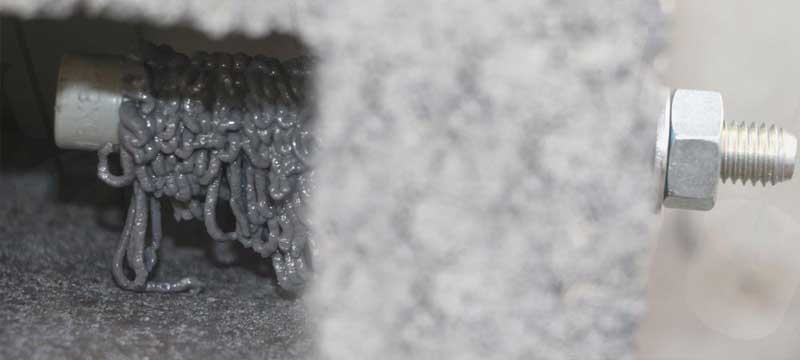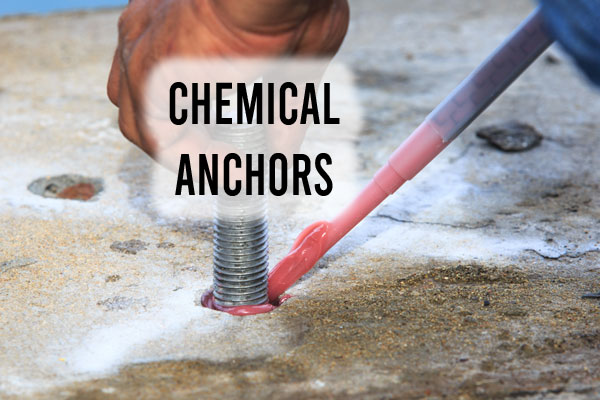Chemical anchors are generic terms relating to steel studs, bolts and anchorages which are bonded into a substrate, usually masonry and concrete, using a resin-based adhesive system. Chemical anchors refer to bonding used between metallic elements and substrate materials. The metallic elements, in this case, include rods, while the substrate material can be brick or mortar. Synthetic resin adhesives are used to form the bond. They are highly effective when used in high load applications. The main importance of chemical anchors and fillings is that they form very strong bonds. These bonds are actually stronger compared to the base materials. Chemical adhesion is used to create these bonds and this means that the base material does not get any load stress. This has made them a more popular option than expansion anchors. These anchors were initially used in concrete that was designed to hold heavy loads.
It is ideally suited for high load applications, in virtually all cases the resulting bond is stronger than the base material itself and as the system is based on chemical adhesion, no-load stress is imparted to the base material as with expansion type anchors and are therefore ideal for close to edge fixing, reduced center and group anchoring and use in the concrete of unknown quality or low compressive strength. Another importance of chemical anchors and fillings is that they are suitable for fixing material that is close to an edge. It is also possible to use them for bonding using reduced compressive strength.
For this type of anchor, you may require different types of bearing to support high-load applications in the construction industry. Tapered Roller Bearings is an expert bearing company that can provide you with whatever type you need for the job. Using high-quality materials, as well as at affordable prices, you can be sure you’ll be getting the best value for money possible.
Types of chemical anchors used in structures
There are five types of chemical anchors used in structures with different specifications, each of them is analysed below.
Polyester chemical anchor
Polyester chemical anchors are a common injection anchoring system in the market that is easy to use and apply widely. 2 components are filled in various sizes of the dual injectable cartridge. It is a reactive resin used for the production of 2-component injection mortar. They are used for fixing steel dowels, staircases, handrails, building facades, sound barriers, pipelines, awnings, brackets, post-installation rebar connections. It can also be used for medium loading, threaded rod and rebar anchoring on dry concrete or uncracked base.

Unsaturated Polyester chemical anchor
An unsaturated polyester chemical anchor is a reactive resin used for the production of a 2-component injection mortar, whereby both unsaturated polyester resins dissolved in styrene (the original resin type) and styrene-free unsaturated polyester resins with styrene related monomers as a reactive solvent are used. Different formulations offer a versatile range of applications and benefits. In modern products, lower level resins are designed for use in masonry and uncracked concrete applications. Whilst at the top end, methacrylates and pure epoxies can be used in more stressful applications, such as cracked concrete, rebar and seismic conditions.
Epoxy acrylate chemical anchor
Epoxy acrylate chemical anchor is a two-component resin of styrene free epoxy acrylate for use in concrete and masonry. It is designed as a fast curing, high strength resin fixing anchor for very high loads and critical fixings especially in corrosive environments or damp conditions. It is applicable for heavy, high-performance loads, rapid curing and low odour, based on styrene-free vinylester technology with high reactivity. It provides very good chemical resistance in highly aggressive environments or under humid conditions, even in underwater anchors. It is also used for fixations in solid construction supports or hollow materials, in walls, columns, facades, floors, etc.

Pure epoxy chemical anchor
Pure Epoxy Standard is a two-component 1:1 ratio pure epoxy bonded anchoring system for use in cracked and uncracked concrete under normal and seismic conditions. Developed for the most demanding structural applications and rebar connections, Chemical Anchor Pure Epoxy Standard guarantees a very high load-bearing capacity. It is designed especially for the Construction Industry. Few applications include anchoring of threaded rods, reinforcing bars or internally threaded rod sleeves into concrete (normal, porous & light) as well as solid masonry. It has a very high bond strength to concrete failure, thus making it suitable for very smooth climate conditions. It is ideally suited for high load applications, the resulting bond is stronger than the base material itself and as the system is based on the adhesion principle, no additional load stress is imparted to the base material as with expansion type anchors and are therefore ideal for close to edge fixing, reduced center and group anchoring and use in the concrete of unknown quality or low compressive strength.

Hybrid systems
The hybrid system includes a two part chemical anchor that is designed to cure fast so you can load the fastening point earlier than you could with an epoxy anchor. It can be used anywhere requiring a threaded rod or rebar into concrete. Whether you require anchorage for structural steel connections such as steel beams or columns to concrete, structures such as racking, sound barriers or fencing, Highly reactive resins can be injected into the borehole before the insertion of the steel stud or bolt. The reacting mixture fills in all irregularities and makes the hole airtight with 100% adhesion, which creates extra load strength. It also reinforces the structure of the concrete walls as well as around the borehole, making it resistant to cracking. Finally, chemical anchoring allows the installer to make slight adjustments to the stud’s alignment while the chemical mixture is still curing.

Conclusion
If you have no idea about the quality of the concrete you are using for construction, chemical anchors are an ideal choice. There are different delivery systems and variations to select from if you intend to use chemical anchors. However, they all rely on a similar fundamental principle. They use a base resin, which is combined with another element to start the curing procedure. It is essential to explore the various resin options available to comprehend the value of chemical anchors. Chemical anchors have virtually unlimited embedment depth, so you can embed any length of rod into the hole to increase the load capacity.
Image Source: anchorfixings.com, gooduse.com.tw, youtube.com,
hilti.com.hk,



